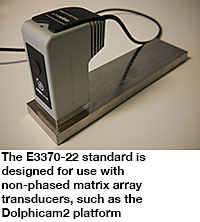New standard for matrix array ultrasonic testing
14/03/2023
In response to a growing demand for matrix array ultrasonic testing (MAUT) standards, ASTM International has recently published ASTM E3370-22, titled: ‘Standard practice for matrix array ultrasonic testing of composites, sandwich core constructions and metals used in aerospace applications’. 
The standard has its origins in ASTM E2580-17, ‘Standard practice for ultrasonic testing of flat panel composites and sandwich core materials used in aerospace applications’, which is intended for use with single-element transducers. The new E3370-22 standard is instead designed specifically for use with non-phased matrix array transducers, such as the Dolphicam2 platform, manufactured by Dolphitech. Such transducers operate with an isotropic matrix array of elements with a small pitch and high count (for example 128 × 128 elements at 0.25 mm pitch), operating in straight beam (ie 0°) mode. As such, they are unique in being capable of live C-scan generation.
As it sits between conventional straight beam ultrasonic testing (UT) and phased array UT (PAUT), MAUT has previously been underrepresented by international standards. Jason Smith, Defence CEO at Dolphitech, said: “We are delighted by the publication of this standard by ASTM International. It provides our customers with a great starting point for building their own inspection procedures, through detailing all aspects that need to be considered. This document will also pave the way for further matrix array UT standards, with ASME and ISO standards already in the pipeline.”
The standard itself covers two modes of operation: test procedure A: pulse echo; and test procedure B: through transmission. In addition, general considerations, such as quality assurance provisions, test apparatus, physical reference standards and reporting requirements, are all discussed in detail. Jack Lambert, Technical Sales Manager at Dolphitech, commented: “It is fantastic to see new technology such as matrix array UT being detailed as an ASTM standard practice. As well as providing new and existing users of this technique with a useful guide, documents such as E3370-22 are vital in ensuring that the international standardisation effort keeps up-to-date with emerging technologies and thus stays relevant to industry practices.”
For more information and to purchase the standard, visit: www.astm.org/e3370-22.html